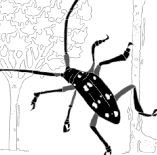FOR MOST PEOPLE, May is a time to break out the sandals, pull the short-sleeved shirts out of the back of the closet (60-degree weather be damned!), and start thinking about summer vacation. But for entomologists, the warm weather marks the start of infestation season: a time when invasive tree-munching critters like the gypsy moth (eight of which were found in Ballard’s Crown Hill neighborhood last year) and the citrus longhorned beetle (let loose in Tukwila in August 2001) start to hatch and feed. Both species, dreaded by lumber companies and horticulturists for their virulence and voracious appetites, can destroy deciduous trees. And the Washington Department of Agriculture says the only solution is to wipe them out before they evolve from a major threat to a downright scourge.
Controversy has raged over the gypsy moth since earlier this year, when the Ag Department announced that it would be spraying all the trees and shrubs in a 16-block area of Crown Hill with a biological pesticide known as Foray 48B. At least 31 residents in the spraying area refused to sign a consent form allowing state pest sprayers on their property; they contended that the pesticide contains several poisons— including an endocrine disrupter and a highly toxic disinfectant—among its so-called “inert ingredients.”
Last week, the neighbors—represented by a lawyer for the anti-pesticide group No Spray Zone—lost their battle in Court when a judge granted the Agriculture Department an “administrative warrant” to enter residents’ property against their will. Claude Ginsberg, president of No Spray Zone, characterized the department’s spraying policy as a “cookie-cutter approach: Whenever they get moths, they just draw a circle around them and spray everything.” But John Lundberg, a spokesperson for the department’s gypsy moth eradication program, says pesticides are the only surefire solution to a full-scale infestation. “We have isolated introductions all the time,” Lundberg says; the real problem is when moth hunters start running across egg masses, which can hatch as many as 100 leaf-gobbling gypsy moth caterpillars.
But the gypsy moth, which has infested 18 states, is a mere head cold compared to the nasty, insidious citrus longhorned beetle, which escaped from a shipment of Korean bonsai trees at a nursery in Tukwila last August. The beetle, which destroys deciduous trees by eating them from the inside, has left a trail of destruction across the country, creating a $369 million headache for New York City and Chicago alone. “This is a very, very serious pest because it kills healthy trees,” says Tonia Buell, spokesperson for the Agriculture Department’s citrus beetle program. So serious, in fact, that the department is going a step beyond pesticides to eradicate it: Come midsummer, the department plans to cut down more than 1,000 trees in Tukwila, a clearcut that will leave hillsides and yards bare within a one-eighth-mile radius along the beetle’s introduction site near I-5. Outside the clearcut area, trees will be injected with pesticide; outside that ring will be a “quarantine zone,” from which trees, clippings, and prunings cannot be removed.
“It’s very fortunate that we’ve detected this beetle before it becomes a big problem,” Buell says. Ordinarily, the beetle is undetectable until it emerges in midsummer, leaving perfectly round exit marks on tree trunks. In Chicago, Buell says, people mistook these markings for bullet holes and thought someone was going around shooting trees. “It was quite a while before people realized it was the beetle,” Buell says.
Ironically, around the same time that the eradication effort is getting underway, Tukwila will receive an award from the National Wildlife Federation certifying it as the first “backyard wildlife habitat” community in the state. Churches, schools, apartment dwellers, and homeowners have worked for months to turn much of Tukwila’s dwindling undeveloped space into a wildlife sanctuary. “It is tragically ironic that we’ll be receiving this award and then, just shortly thereafter, the state’s going to come in and clear-cut these trees,” says Michelle Roedel, head of Tukwila’s habitat program. “I understand why they’re making this decision, but that doesn’t make it any less tragic.”
The cutting will destroy songbird, hawk, and mammal habitats and create potential erosion and chemical runoff problems on wooded hillsides where many houses have been built. Buell says the Agriculture Department will work to replace the trees with “nonhost” (mostly evergreen) species and will give homeowners a “menu” of options to replace their maples, willows, and fruit trees. “We realize that this is going to personally affect the residents,” Buell says. “It’s not something they’re happy about, but they do seem to understand that this is a serious problem.”







